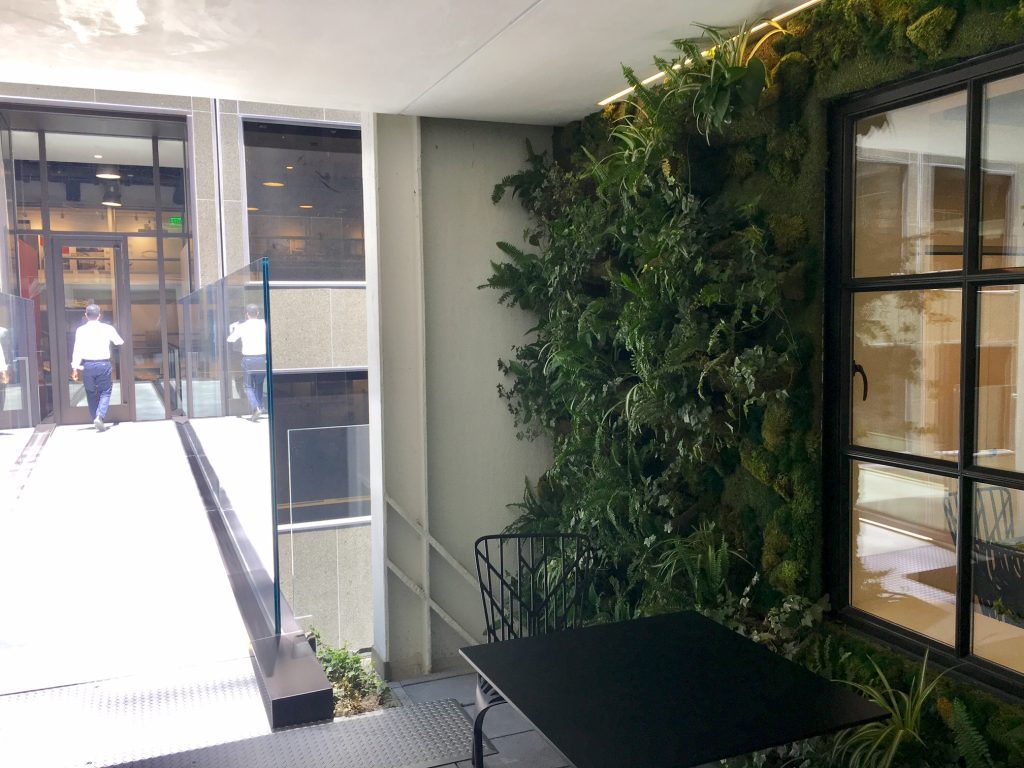Sometimes it’s difficult to get people to embrace change. One happy exception is the adoption of the LEED building standard. Developed by the U.S. Green Building Council in just the past 13 years, it’s now the standard for energy-saving, cost-efficient building the United States. It provides rating systems for everything from design to maintenance to materials and operation. It applies to everything from luxury homes to the new stadiums in San Francisco and Minneapolis.
The design firm Gensler is at the forefront of both LEED and WELL Building Standard certification. Gensler’s Los Angeles office includes our new living wall bridge.Thanks to LEED, most people have a basic idea of the ways green building practices should be applied as the norm: energy efficiency, improve air, access to daylight and outside views. The federal government and 46 states all apply LEED standards to new construction. (Come on, Alabama, Georgia, Maine, and Mississippi).
LEED has served us well so far. But LEED only applies to the effect of buildings on the environment. While this has an indirect effect on all of us by caring for the health of our planet, LEED doesn’t really take into account how design and building affects the physical and mental health of human beings. Because of our increasingly urbanized lives, we need to work hard at incorporating the positive effects of our natural world into our built environment.
This is where the WELL Building Standard picks up the baton. When I first heard about this concept in 2015 at the Urban Land Institute, the potential for revolutionizing our approach to building seemed obvious to me.
Two years later, I’m happy to see the WELL Building Standard being embraced by thought leaders. But we’re still in the early stages of acceptance, like we once were with the LEED building standard. The International WELL Building Standard just released a new video last week illustrating the concept. In just three minutes, you’ll know why I’m so enthusiastic about it.
WELL doesn’t compete with the LEED standard. The two work together. But the WELL Building Standard has a different focus. LEED is about buildings. WELL is about people.
The WELL Building Standard® addresses seven categories of architecture and design conditions which enhance the health and well-being of occupants: Air, Water, Nourishment, Light, Fitness, Comfort and Mind.
At its core is the concept of biophilia and biophilic design, the recognition of the human connection to nature and the positive effects of nature on our health and wellness. It looks at everything from the amount of exposure to natural light, to color palettes, to the food offered in a company cafeteria, to the presence of nature in a building in the form of living plants. Indoor potted plants and vertical gardens or walls are specifically called for as part of the certification standards.
The WELL Building Standard is grounded in solid science. The WELL Building Standard is the culmination of seven years of medical research in collaboration with leading doctors, scientists, architects and other wellness professionals.

Levis Stadium in San Francisco is one of the largest WELL Building Standard compliant structures in the world. Photo: Courtesy Levi’s Stadium website.
So far, more than 10 million square feet of projects have already registered or certified through WELL. It’s a good start. California has the most WELL certified projects with 64 total, the most of any state or country. Several are in San Diego including the offices of architecture and design firm Gensler and the new La Jolla Commons Phase III office building in the UTC area. The Inn at Moonlight Beach in Encinitas is currently closed for renovations under new owners, and they’ve registered for WELL Building certification. There are also several unnamed projects in Chula Vista registered for the future.
It will take a little time to catch up with LEED certified projects. LEED has grown to become the world’s most widely used green building rating system, with nearly 80,000 projects participating in LEED across 162 countries, including more than 32,500 certified commercial projects as of 2016. You can see a map of completed LEED certified projects as of July 13, 2016 in the San Diego area here. There are a total of 557 projects mapped with a combined 55,663,216.82 square feet of space.
Unless you live on a farm or in a rural area, you spend as much as 90 percent of your time inside buildings: work, home, restaurants, movie theaters, and so on. Just like we now recognize the danger to our health of sitting for hours at a time, we understand the harm being done when we live and work in unhealthy buildings where there is no recognition of our biophilic connection to nature.
One of the reasons LEED has been so successful is how quickly the average American grasped its value, and started making it a priority in their business decisions. The building industry is well versed now in sustainability standards; it’s nearly a given. Wellness for the human occupants is the next step. We are able to take evidence-based scientific research about biophilia and wellness, and use it to improve our buildings with the WELL Building Standard. We can make workplaces healthier, and we can make the bottom line healthier too by improving employee productivity and retention. Employee satisfaction is a key predictor of business performance.
I’m eager to see WELL working hand in hand with LEED to create buildings that are not only energy efficient, but also welcoming and comfortable spaces where people can live and work productively, in good health.


